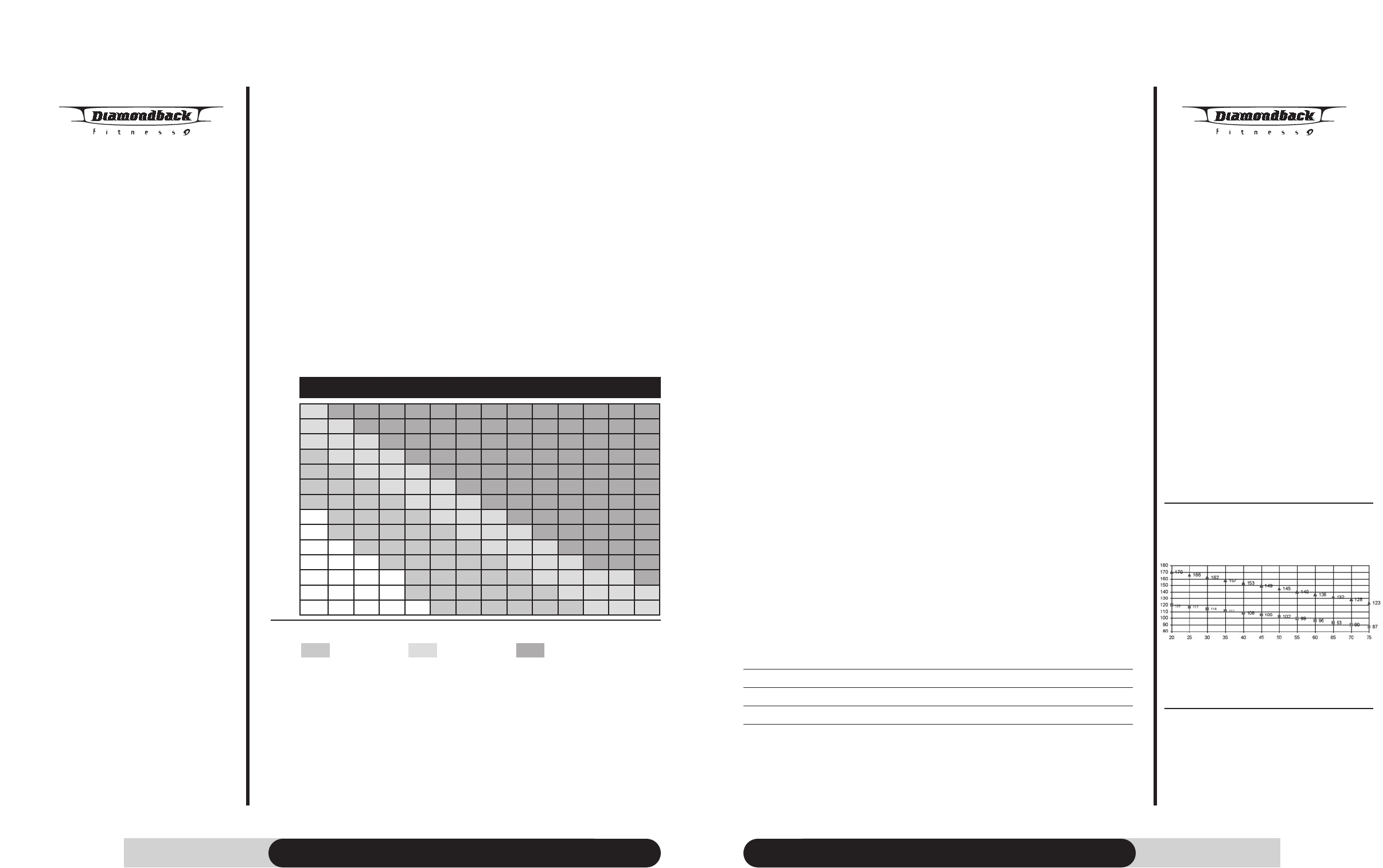
Good health is an exercise in common sense
The Surgeon General released a new study in 2001, The Surgeon General’s Call
To Action To Prevent and Decrease Overweight and Obesity. It indicates that 61%
of American adults are either overweight or obese. The story states that overweight
increases the risk of health problems, such as heart disease, certain type of cancer,
type 2 diabetes, etc. It further points out that overweight needs to be regarded pri-
marily as a Health rather than as an Appearance issue.
The Surgeon General’s Healthy weight advice for consumers is:
1. Aim for a healthy weight: Find your Body Mass Index (BMI) on the chart below.
2. Be active: Keep physically active to balance the calories you consume.
3. Eat well: Select sensible portion sizes.
Heart rate is an important key to your exercise.
The Surgeon General also released a report on physical activity and health. This
report definitively stated that exercise and fitness are beneficial for a person’s
health and r
edefined that exercise is a key component of disease prevention and
healthier living.
10
1180 Er Owner’s Manual 1180 Er Owner’s Manual
11
Workout guidelines (continued)Workout guidelines
Medical research has shown us that there is an amount of exercise, which is
enough to condition the cardio respiratory system and the muscles of the body.
This amount of exercise is between 60% and 85% of your maximum heart rate
measured during a training session. This range allows enough exercise to achieve
fitness, but not an excessive amount to cause injury. Your heart rate is an excellent
indicator of the amount of stress placed on the cardiovascular system. Taking full
advantage of this information, the 1180Er is designed to include heart rate moni-
toring features.
If exercise intensity is too low or too high, no gains will be made in fitness. If the
intensity is too low, the stress levels are ineffective. If the intensity is too high, injury
or fatigue may set your exercise program back as you try to recover.
The best way to monitor exercise intensity is to accurately count your pulse during
exercise. Your heart rate can easily be determined by counting your pulse at the
chest, wrist or at the carotid artery on your neck. It is difficult to count your own
pulse during exercise, mainly because you cannot count fast enough to get an accu-
rate number. The 1180Er is equipped with a wireless telemetry receiving system.
What it does is automatically count your heart rate while you are wearing a heart
rate chest belt during your exercising period. Heart rate is monitored and electron-
ically displayed as a digital readout. Your target heart rate, the intensity needed to
improve cardiovascular fitness, depends primarily on your age and not your state of
fitness. It is calculated as a percentage of your maximum heart rate, estimated as
220 minus your age. It is most effective to train at your target heart rate between
60% and 85% of your maximum hear
t rate.
Maximum Heart Rate & Training Zone
To calculate your maximum heart rate and find your training zone, use the fol-
lowing for
mula. An example has been provided below based for a 35-year
–old person:
220 – Age = Maximum Hear
t Rate
(220 – 35 = 185)
60% of Maximum Heart Rate (60% x 185 = 111bpm)
85% of Maximum Heart Rate (85% x 185 = 157bpm)
T
raining Zone:
111bpm – 157bpm
Note: Always enter your age into the console before you exercise to
keep the % of your maximum heart rate accurate.
29 31 34 36 39 41 43 46 48 51 53 56 58 60
27 29 31 34 36 38 40 43 45 47 49 52 54 56
25 27 29 31 34 36 38 40 42 44 46 48 50 52
23 25 27 29 31 33 35 37 39 41 43 45 47 49
22 24 26 27 29 31 33 35 37 38 40 42 44 46
21 22 24 26 28 29 31 33 34 36 38 40 41 43
19 21 23 24 26 27 29 31 32 34 36 37 39 40
18 20 21 23 24 26 27 29 30 32 34 35 37 38
17 19 20 22 23 24 26 27 29 30 32 33 35 36
16 18 19 20 22 23 24 26 27 28 30 31 33 34
15 17 18 19 21 22 23 24 26 27 28 30 31 32
15 16 17 18 20 21 22 23 24 26 27 28 29 30
14 15 16 17 19 20 21 22 23 24 25 27 28 29
13 14 15 17 18 19 20 21 22 23 24 25 26 28
120 130 140 150 160 170 180 190 200 210 220 230 240 250
4’6
4’8
4’10
5’0
5’2
5’4
5’6
5’8
5’10
6’0
6’2
6’4
6’6
6’8
BMI = (weight (lb) ÷ height
2
(in)) x 703
Weight in Pounds
Healthy Weight Overweight Obese
Note: This chart is for adults (aged 20 years and older).
Height in Feet and Inches
Heart Rate Guidelines
60% - 85% Maximum Target
Ages in years
▲ = 85% ■ = 60%


















